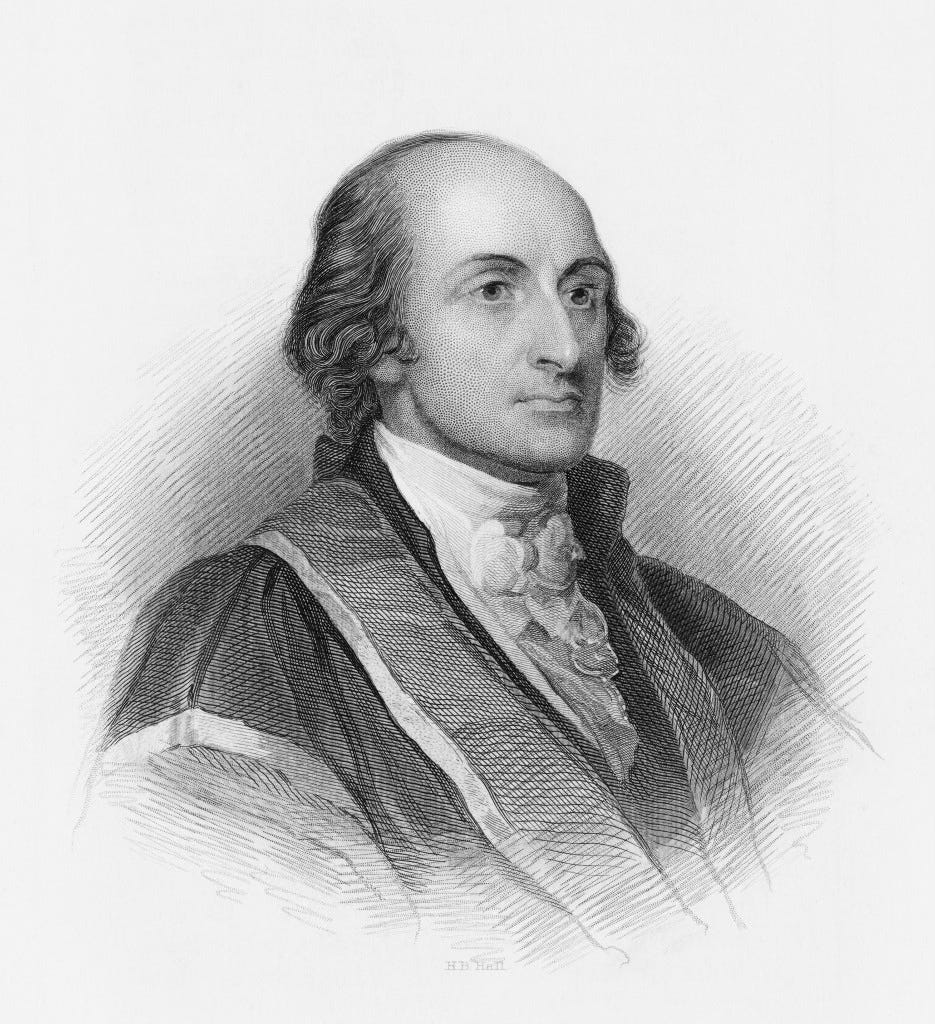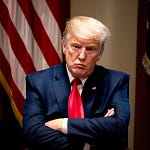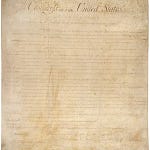This Day in Legal History: John Jay First SCOTUS
On November 6, 1789, John Jay was sworn in as the first Chief Justice of the United States, marking a foundational moment in the development of the federal judiciary. Appointed by President George Washington, Jay was a prominent figure in the American founding, having co-authored The Federalist Papers and served as President of the Continental Congress. His confirmation by the Senate came just weeks after the Judiciary Act of 1789 formally established the structure of the federal court system, including the Supreme Court. At the time of his appointment, the Court held limited power and prestige, lacking even a permanent home or a defined role within the balance of government.
Jay’s tenure as Chief Justice lasted from 1789 to 1795 and was characterized more by circuit riding—traveling to preside over lower federal courts—than by Supreme Court rulings. Nonetheless, he helped lay the procedural and institutional groundwork for the Court’s future authority. One of his few significant decisions came in Chisholm v. Georgia (1793), which asserted that states could be sued in federal court, a holding that was quickly overturned by the Eleventh Amendment. Jay also took on diplomatic duties, most notably negotiating the controversial Jay Treaty with Great Britain in 1794, which aimed to resolve lingering tensions from the Revolutionary War.
Though his judicial legacy on the bench was modest, Jay’s influence as the Court’s inaugural leader was crucial in legitimizing the judiciary as a coequal branch of government. He later declined a reappointment to the position in 1800, citing the Court’s lack of power and institutional independence. The role of Chief Justice would eventually evolve into a central force in constitutional interpretation, but it was Jay who first gave the office its shape. This milestone in legal history underscores the slow and deliberate construction of American judicial authority, which did not arrive fully formed but was built case by case, institution by institution.
The Supreme Court is currently reviewing Learning Resources Inc. v. Trump, a case that raises major constitutional and statutory questions about the scope of presidential power—particularly in the context of tariffs imposed under the International Emergency Economic Powers Act (IEEPA). At the heart of the dispute is whether the word “regulate” in IEEPA grants the president the authority to impose tariffs without explicit congressional approval. The case touches on foundational issues in constitutional law, including statutory interpretation, the nondelegation doctrine, emergency powers, and the “major questions” doctrine. The Court must assess not just what the statute says, but also how to interpret the silence—IEEPA never mentions “tariffs” or “taxes”—in light of Congress’s constitutional power to impose taxes and regulate foreign commerce.
From a textualist standpoint, the omission of “tariffs” suggests Congress did not intend to delegate that taxing authority to the executive. From a purposivist view, the debate turns on whether Congress meant to arm the president with broad economic tools to respond to emergencies or to narrowly limit those powers to national security concerns. Additional arguments center on legislative history and the principle of avoiding surplusage, as opponents claim interpreting “regulate” to include “tariff” would render other statutes that explicitly mention tariffs redundant.
The nondelegation doctrine also plays a key role. If IEEPA is read to permit the president to impose tariffs, critics argue it may represent an unconstitutional transfer of legislative power—particularly taxing power—absent a clear “intelligible principle” to guide executive discretion. The Court is also being asked to consider whether the president’s determination of an “emergency” under IEEPA is reviewable and whether actions taken in response to such emergencies must still adhere to constitutional limits. The outcome of this case could significantly redefine the boundary between congressional authority and executive power in trade and economic policy.
The U.S. Supreme Court heard arguments on November 5, 2025, in a case challenging President Donald Trump’s use of emergency powers to impose sweeping tariffs under the International Emergency Economic Powers Act (IEEPA). Justices from across the ideological spectrum questioned whether Trump had exceeded his authority by bypassing Congress to enact tariffs, which are traditionally under legislative control. The legal debate centered on whether IEEPA’s grant of authority to “regulate importation” includes the power to impose long-term tariffs, and whether doing so constitutes a “major question” requiring explicit congressional authorization.
Chief Justice John Roberts, among others, expressed concern that Trump’s use of IEEPA effectively allowed the executive to impose taxes—a core congressional function. Justice Amy Coney Barrett asked whether there was any precedent for interpreting “regulate importation” as tariff-imposing authority, while Justice Elena Kagan and Justice Ketanji Brown Jackson emphasized that IEEPA was designed to limit, not expand, presidential power. Some conservative justices, like Brett Kavanaugh, were more receptive, referencing historical precedents like Nixon’s use of similar powers.
The administration argued the tariffs were necessary to respond to trade deficits and national security threats and warned that removing them could lead to economic harm. But critics, including business representatives and Democratic-led states, warned of a dangerous shift in power toward the executive. Justice Neil Gorsuch suggested such an interpretation of IEEPA could permanently shift trade powers away from Congress, violating constitutional checks and balances.
Lawyer for Trump faces tough Supreme Court questions over legality of tariffs | Reuters
The U.S. Senate confirmed Eric Tung to the Ninth Circuit Court of Appeals in a 52-45 party-line vote, making him President Donald Trump’s sixth appellate court appointee in his second term. Tung, a former federal prosecutor and Justice Department lawyer, most recently worked at Jones Day, where he focused on commercial litigation and frequently represented cryptocurrency interests. His confirmation came over the objections of California’s Democratic senators, who criticized his past statements and writings on issues such as abortion, same-sex marriage, and gender roles.
Tung has been a vocal legal advocate for controversial positions, including support for the independent state legislature theory and the argument that stablecoin sales fall outside SEC regulation. While he pledged to follow Supreme Court precedent, critics raised concerns about his originalist approach to constitutional rights. He faced intense scrutiny during his confirmation hearings for remarks made at a Federalist Society event and earlier in life, including statements about gender roles that drew fire from Senator Alex Padilla.
Despite these concerns, Tung’s legal career earned strong endorsements from colleagues and conservative legal allies. He clerked for Justices Antonin Scalia and Neil Gorsuch and has experience handling judicial nominations from within DOJ. Tung fills the seat vacated by Judge Sandra Segal Ikuta, a fellow conservative, ensuring ideological continuity on the Ninth Circuit.
Former DOJ, Jones Day Lawyer Confirmed as Ninth Circuit Judge
The California Republican Party filed a federal lawsuit against Governor Gavin Newsom, seeking to block the implementation of new congressional maps approved by voters just a day earlier via Proposition 50. The measure, backed by Newsom and passed by wide margins, suspends the state’s independent redistricting commission and installs a Democratic-leaning map that could endanger five Republican-held congressional seats. Newsom has framed the move as a direct response to Texas’ mid-cycle redistricting, which is expected to boost Republican power in the 2026 midterms.
The GOP lawsuit, filed in the U.S. District Court for the Central District of California, argues that the new maps violate the Equal Protection Clause of the Fourteenth Amendment by using race as the primary factor in redrawing districts to favor Hispanic voters. The plaintiffs, represented by attorney Mike Columbo of the Dhillon Law Group, claim the state legislature lacked sufficient justification to use race in this way and failed to meet the legal standards required under the Voting Rights Act.
Republicans also contend that Proposition 50 diminishes the political voice of non-Hispanic groups and constitutes unconstitutional racial gerrymandering. The suit, Tangipa v. Newsom, is backed by the National Republican Congressional Committee and includes Republican lawmakers and candidates as plaintiffs. It mirrors legal challenges in Texas, where courts are evaluating claims of racial bias in redistricting. The outcome of these cases could significantly affect congressional control heading into the latter half of President Trump’s second term.
California Republicans Sue to Block New Congressional Maps (1)













